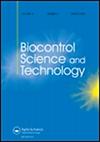Application of Lactobacillus spp. for the biological management of green mold (Penicillium digitatum) on sweet orange fruit under in vitro and storehouse conditions
IF 1.2
4区 农林科学
Q4 BIOTECHNOLOGY & APPLIED MICROBIOLOGY
引用次数: 1
Abstract
ABSTRACT This study aimed to investigate the use of probiotic lactic acid bacteria including Lactobacillus brevis, L. plantarum, L. helveticus and L. delbrueckii from dairy products against Penicillium digitatum (green mold) on sweet orange fruit. Antifungal activity of Lactobacillus spp. was first assayed using bacterial cells through the overlay method against 105 spore/mL suspension of P. digitatum. Also, P. digitatum growth inhibition was measured in the PDA medium containing 15 and 30% cell-free supernatant (CFS) of Lactobacillus spp. Antifungal activity of Lactobacillus spp. was evaluated under storehouse conditions by treating wounded fruits with 108/mL cell suspension (CS) and 30% CFS of Lactobacillus spp., which then infected with 105/mL spore suspension of P. digitatum. The CS and CFS of L. plantarum had the best antifungal activity under both in vitro and in vivo conditions followed by L. helveticus, L. delbrueckii and L. brevis. L. plantarum. The 15 and 30% L. plantarum CFS were able to inhibit the growth of P. digitatum by 30.31%, 76.82% and 97.6% respectively, under in vitro conditions. Also, L. plantarum CS and 30% CFS reduced the growth of the P. digitatum on the fruit by 92.77 and 98.9% respectively, under storehouse conditions. The total content of all sugars of treated fruits with Lactobacillus spp., CS and CFS showed significant difference compared to untreated fruits. Therefore, the present study highlights the successful application of biological fungicides based on secondary compounds of Lactobacillus spp. due to greater stability of metabolites than bacterial cells in the environment. GRAPHICAL ABSTRACT乳酸菌在甜橙果实中青霉(指青霉)生物管理中的应用
摘要本研究旨在研究乳制品中的短乳杆菌、植物乳杆菌、helveticus乳杆菌和delbrueckii乳杆菌等益生菌对甜橙果实中指状青霉(绿霉菌)的拮抗作用。采用细菌细胞覆盖法测定了乳杆菌对105孢子/mL指状假单胞菌悬液的抑菌活性。同时,在含有15%和30%无细胞上清(CFS)的PDA培养基中测定了digitatum的生长抑制作用,并在贮藏条件下用108/mL细胞悬浮液(CS)和30%无细胞上清液(CFS)处理伤果,再用105/mL的digitatum孢子悬浮液感染伤果,考察了Lactobacillus spp的抑菌活性。在体外和体内条件下,植物乳杆菌的CS和CFS的抑菌活性最好,其次是helveticus、delbrueckii和L. brevis。l .杆菌。在体外条件下,15%和30%植物乳杆菌CFS对指状假单胞菌生长的抑制作用分别为30.31%、76.82%和97.6%。在贮藏条件下,植物l.s tarum CS和30% CFS分别使指状小檗在果实上的生长减少了92.77%和98.9%。经乳杆菌、CS和CFS处理的果实总糖含量与未处理的果实相比差异显著。因此,本研究强调了基于乳杆菌次级化合物的生物杀菌剂的成功应用,因为乳杆菌的代谢物比细菌细胞在环境中更稳定。图形抽象
本文章由计算机程序翻译,如有差异,请以英文原文为准。
求助全文
约1分钟内获得全文
求助全文
来源期刊
CiteScore
3.20
自引率
7.10%
发文量
64
审稿时长
4-8 weeks
期刊介绍:
Biocontrol Science and Technology presents original research and reviews in the fields of biological pest, disease and weed control. The journal covers the following areas:
Animal pest control by natural enemies
Biocontrol of plant diseases
Weed biocontrol
''Classical'' biocontrol
Augmentative releases of natural enemies
Quality control of beneficial organisms
Microbial pesticides
Properties of biocontrol agents, modes of actions and methods of application
Physiology and behaviour of biocontrol agents and their interaction with hosts
Pest and natural enemy dynamics, and simulation modelling
Genetic improvement of natural enemies including genetic manipulation
Natural enemy production, formulation, distribution and release methods
Environmental impact studies
Releases of selected and/or genetically manipulated organisms
Safety testing
The role of biocontrol methods in integrated crop protection
Conservation and enhancement of natural enemy populations
Effects of pesticides on biocontrol organisms
Biocontrol legislation and policy, registration and commercialization.

 求助内容:
求助内容: 应助结果提醒方式:
应助结果提醒方式:


